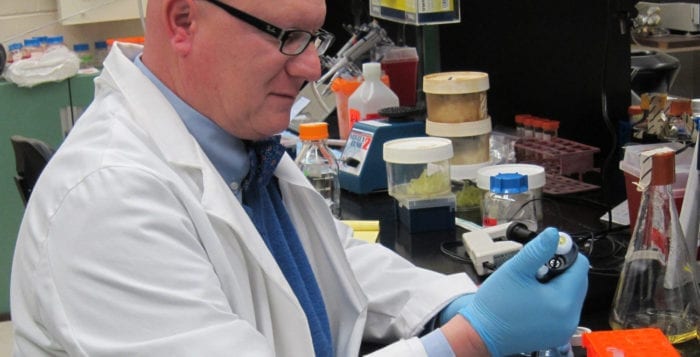Environmental experts fear the impact of deer on local forests
Deer have made a mess out of the Long Island ecology.
It’s a sentiment shared by several federal employees working in multiple environmental departments. At a presentation held in the Port Jefferson Village Center April 11, Thomas Rawinski, who works for the U.S. Department of Agriculture Forest Service, said deer eat the saplings that would create new trees. They eat the bushes and flowers that would bring insects to the forests. And since they have no natural predators on Long Island, they multiply at an alarming rate.
“If your land is healthy, you can sit back and rest on your laurels,” Rawinski said. “If it’s not, like every damn forest on Long Island, then somebody has work to do, including me.”
Crowded into the Port Jefferson Village Center, residents of both the Village of Port Jefferson and Village of Belle Terre spoke about their own experiences with deer, but it all begs the question: What are the local villages going to do?
“I can tell you the level of deer damage on the east end is the worst I’ve seen in New York.”
— Thomas Desisto
The villages of Belle Terre and Port Jefferson have been working out the details on some sort of organized deer hunt, either a coordinated hunt or deer culling, one that could likely happen at the Port Jefferson golf course.
“It’s either going to be a controlled hunt or it’s going to be a cull,” Port Jeff Mayor Margot Garant said. “I don’t know which way we’re going to go but we’re going to figure it out.”
Talks have been ongoing since January, where both Garant and Belle Terre Mayor Bob Sandak have expressed their intent to split the cost of a deer culling, which would likely be performed by the U.S. Department of Agriculture. This would involve a specialized team of hunters using thermal imaging and silenced rifles to kill deer from elevated positions at night. The cost could be expensive, with some estimates as high as $1,000 per deer.
Thomas DeSisto, a wildlife specialist with the USDA said the operation is mandated to charge for their services, as they get all their funding through cooperative service agreements. While the cost hasn’t deterred the mayors from finding a solution, DeSisto said there are issues with performing a culling on Long Island due to regulation by the New York Department of Environmental Conservation.
In 2017, new legislation has restricted hunting to the point that DeSisto said fundamentally restricts the culling process. In Suffolk County, hunting is restricted to bows, or to muzzle-loaded rifles during the January hunting season. In addition, hunters are not allowed to keep loaded firearms within vehicles, use of bait is not allowed within 300 feet of a roadway, and hunters are not allowed to discharge firearms from the road.
“We’ve seen about 50 percent decrease in efficiency in our upstate program, and on Long Island we’ve seen a 75 percent decrease in efficiency,” he said. “I can tell you the level of deer damage on the east end is the worst I’ve seen in New York.”
In January, Belle Terre changed its village code to allow hunting within the premises, saying they had received an opinion by the state attorney general who said that no municipality other than New York State could regulate hunting.
While some village members shared fears of hunting going on so close to their homes, and shared a general distaste for killing animals, Sandak said so far, the change in code, and the facilitating of hunters, has been a success. He estimates since the village allowed hunting approximately 100 deer have been killed.
“Five years ago, if you were in your car and you saw a deer, you took out your phone and took a picture of it, because it was an oddity,” Sandak said. “Now, it’s unbelievable.”
The New York State DEC allows residents to apply for Deer Damage Permits, which allow property owners to hunt or allow hunters outside of the normal season. The Belle Terre mayor said to his knowledge there are three residents in Belle Terre with DDPs.
“Five years ago, if you were in your car and you saw a deer, you took out your phone and took a picture of it, because it was an oddity.”
— Bob Sandak
Port Jefferson currently has code on the books that says discharging any kind of firearm, bow or crossbow is strictly prohibited. Garant said village officials are still looking at changing the code so it will allow hunting, conforming to what the state attorney general has said. However, she added the village could not and would not go after residents who break the code and allow hunting on their own property.
Sue Booth Binczik, wildlife biologist with the New York Department of Wildlife Conservation, spoke to those who attended the meeting, echoing Rawinski by saying deer lead to reduced diversity, more invasive plants and fewer canopy and trees.
Deer are perhaps the most efficient devastators of the local ecology. For one, they have prolific breeding patterns. Binczik said does can start to breed at 1 year old and can give birth to two fawns per year in May and June. While deer are naturally prey animals, Long Island shows a distinct lack of natural predators to cull their numbers. An average deer can live to be 20, and while vehicles and hunters may start to pick off the occasional deer, stags can mate with any number of females, ever increasing the population. The only things left to kill the deer are recreational hunters, starvation, but especially moving vehicles.
“Under ideal conditions the deer populations can double every two to three years,” she said. “The reason they have this high reproductive rate is because they’re a prey species.”
State DEC regulations require that hunters only use a bow and arrow and only during the hunting season, barring a DDP permit. Hunters must also shoot 150 feet away from any structures with a bow, and of course they are not allowed to trespass onto other residents’ property without permission.
Binczik said there are means to get a community involved by completing a “controlled hunt,” which would require each individual homeowner to give permission for the village to hunt on their property. Those participating community members would come together to decide on a set of rules for any hunters participating, including the qualifications of the hunters and the times the hunters would be allowed out.
“There have been communities in upstate New York that have been running for controlled hunts for decades, and they have been very happy with it,” she said.
Despite all these efforts, Rawinski remains skeptical. He said it comes from years of seeing the damage that deer have caused to the local wildlife. People, he said, have to wake up to it. While by the roadside it may seem the forests are blooming with green, but it’s a symptom of what he called the “great green lie,” that while it may seem the forests are lush, on the ground, there’s not much left.
“It’s hard to come by solutions, especially in this suburban situation,” he said. “Humans have a can-do attitude, but I have to tell you, we’re up against our match. I don’t hate deer. I hate what people have let them do to the ecosystem.”





 The Village of Northport will hold its annual Easter Egg Hunt on April 21 at Northport Village Park at 1 p.m. Rain date is April 28. Sponsored by the Northport/Centerport Lions Club. Call 516-380-6444 for additional details.
The Village of Northport will hold its annual Easter Egg Hunt on April 21 at Northport Village Park at 1 p.m. Rain date is April 28. Sponsored by the Northport/Centerport Lions Club. Call 516-380-6444 for additional details.










 On the tax front, Long Islanders, according to the governor’s report, pay some of the highest property tax bills in the United States. Over the last 20 years, Cuomo said, local property taxes rose twice as fast as the average income.
On the tax front, Long Islanders, according to the governor’s report, pay some of the highest property tax bills in the United States. Over the last 20 years, Cuomo said, local property taxes rose twice as fast as the average income.
































 Once the bleeding stops we can evaluate and clean the wound. What is safe to use to clean the wound? Running the wound under a hose or tap will remove dirt and other debris. Studies have shown tap water does not cause significant tissue damage when compared to isotonic saline.
Once the bleeding stops we can evaluate and clean the wound. What is safe to use to clean the wound? Running the wound under a hose or tap will remove dirt and other debris. Studies have shown tap water does not cause significant tissue damage when compared to isotonic saline.



